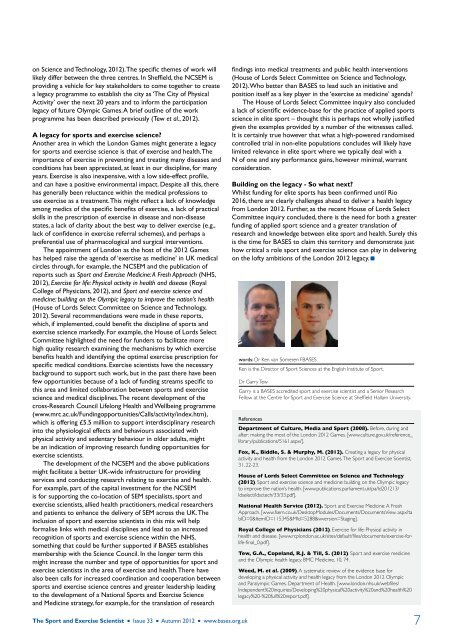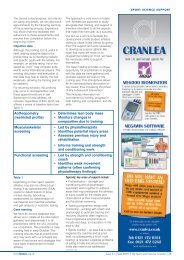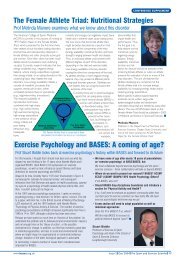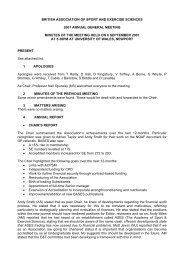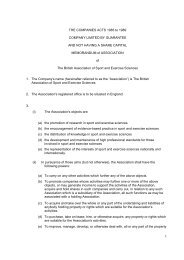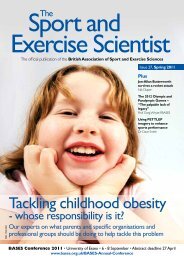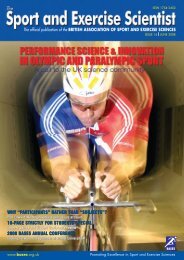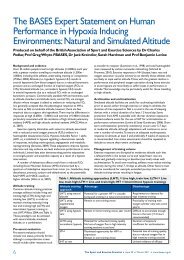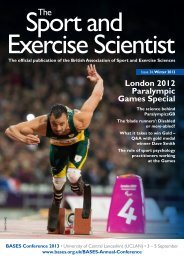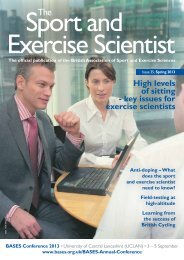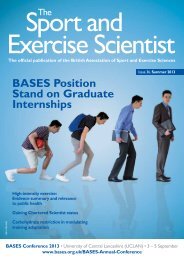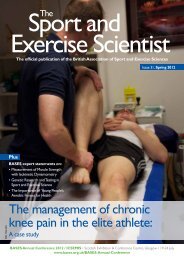Issue 33 Autumn 2012 - Bases
Issue 33 Autumn 2012 - Bases
Issue 33 Autumn 2012 - Bases
- No tags were found...
You also want an ePaper? Increase the reach of your titles
YUMPU automatically turns print PDFs into web optimized ePapers that Google loves.
on Science and Technology, <strong>2012</strong>). The specific themes of work willlikely differ between the three centres. In Sheffield, the NCSEM isproviding a vehicle for key stakeholders to come together to createa legacy programme to establish the city as ‘The City of PhysicalActivity’ over the next 20 years and to inform the participationlegacy of future Olympic Games. A brief outline of the workprogramme has been described previously (Tew et al., <strong>2012</strong>).A legacy for sports and exercise science?Another area in which the London Games might generate a legacyfor sports and exercise science is that of exercise and health. Theimportance of exercise in preventing and treating many diseases andconditions has been appreciated, at least in our discipline, for manyyears. Exercise is also inexpensive, with a low side-effect profile,and can have a positive environmental impact. Despite all this, therehas generally been reluctance within the medical professions touse exercise as a treatment. This might reflect a lack of knowledgeamong medics of the specific benefits of exercise, a lack of practicalskills in the prescription of exercise in disease and non-diseasestates, a lack of clarity about the best way to deliver exercise (e.g.,lack of confidence in exercise referral schemes), and perhaps apreferential use of pharmacological and surgical interventions.The appointment of London as the host of the <strong>2012</strong> Gameshas helped raise the agenda of ‘exercise as medicine’ in UK medicalcircles through, for example, the NCSEM and the publication ofreports such as Sport and Exercise Medicine: A Fresh Approach (NHS,<strong>2012</strong>), Exercise for life: Physical activity in health and disease (RoyalCollege of Physicians, <strong>2012</strong>), and Sport and exercise science andmedicine: building on the Olympic legacy to improve the nation’s health(House of Lords Select Committee on Science and Technology,<strong>2012</strong>). Several recommendations were made in these reports,which, if implemented, could benefit the discipline of sports andexercise science markedly. For example, the House of Lords SelectCommittee highlighted the need for funders to facilitate morehigh quality research examining the mechanisms by which exercisebenefits health and identifying the optimal exercise prescription forspecific medical conditions. Exercise scientists have the necessarybackground to support such work, but in the past there have beenfew opportunities because of a lack of funding streams specific tothis area and limited collaboration between sports and exercisescience and medical disciplines. The recent development of thecross-Research Council Lifelong Health and Wellbeing programme(www.mrc.ac.uk/Fundingopportunities/Calls/activity/index.htm),which is offering £5.5 million to support interdisciplinary researchinto the physiological effects and behaviours associated withphysical activity and sedentary behaviour in older adults, mightbe an indication of improving research funding opportunities forexercise scientists.The development of the NCSEM and the above publicationsmight facilitate a better UK-wide infrastructure for providingservices and conducting research relating to exercise and health.For example, part of the capital investment for the NCSEMis for supporting the co-location of SEM specialists, sport andexercise scientists, allied health practitioners, medical researchersand patients to enhance the delivery of SEM across the UK. Theinclusion of sport and exercise scientists in this mix will helpformalise links with medical disciplines and lead to an increasedrecognition of sports and exercise science within the NHS,something that could be further supported if BASES establishesmembership with the Science Council. In the longer term thismight increase the number and type of opportunities for sport andexercise scientists in the area of exercise and health. There havealso been calls for increased coordination and cooperation betweensports and exercise science centres and greater leadership leadingto the development of a National Sports and Exercise Scienceand Medicine strategy, for example, for the translation of researchThe Sport and Exercise Scientist n <strong>Issue</strong> <strong>33</strong> n <strong>Autumn</strong> <strong>2012</strong> n www.bases.org.ukfindings into medical treatments and public health interventions(House of Lords Select Committee on Science and Technology,<strong>2012</strong>). Who better than BASES to lead such an initiative andposition itself as a key player in the ‘exercise as medicine’ agenda?The House of Lords Select Committee inquiry also concludeda lack of scientific evidence-base for the practice of applied sportsscience in elite sport – thought this is perhaps not wholly justifiedgiven the examples provided by a number of the witnesses called.It is certainly true however that what a high-powered randomisedcontrolled trial in non-elite populations concludes will likely havelimited relevance in elite sport where we typically deal with aN of one and any performance gains, however minimal, warrantconsideration.Building on the legacy - So what next?Whilst funding for elite sports has been confirmed until Rio2016, there are clearly challenges ahead to deliver a health legacyfrom London <strong>2012</strong>. Further, as the recent House of Lords SelectCommittee inquiry concluded, there is the need for both a greaterfunding of applied sport science and a greater translation ofresearch and knowledge between elite sport and health. Surely thisis the time for BASES to claim this territory and demonstrate justhow critical a role sport and exercise science can play in deliveringon the lofty ambitions of the London <strong>2012</strong> legacy.words: Dr Ken van Someren FBASESKen is the Director of Sport Sciences at the English Institute of Sport.Dr Garry TewGarry is a BASES accredited sport and exercise scientist and a Senior ResearchFellow at the Centre for Sport and Exercise Science at Sheffield Hallam University.ReferencesDepartment of Culture, Media and Sport (2008). Before, during andafter: making the most of the London <strong>2012</strong> Games. [www.culture.gov.uk/reference_library/publications/5161.aspx/].Fox, K., Biddle, S. & Murphy, M. (<strong>2012</strong>). Creating a legacy for physicalactivity and health from the London <strong>2012</strong> Games. The Sport and Exercise Scientist,31, 22-23.House of Lords Select Committee on Science and Technology(<strong>2012</strong>). Sport and exercise science and medicine: building on the Olympic legacyto improve the nation’s health. [www.publications.parliament.uk/pa/ld<strong>2012</strong>13/ldselect/ldsctech/<strong>33</strong>/<strong>33</strong>.pdf].National Health Service (<strong>2012</strong>). Sport and Exercise Medicine: A FreshApproach. [www.fsem.co.uk/DesktopModules/Documents/DocumentsView. aspx?tabID=0&ItemID=115345&MId=5288&wversion=Staging].Royal College of Physicians (<strong>2012</strong>). Exercise for life: Physical activity inhealth and disease. [www.rcplondon.ac.uk/sites/default/files/documents/exercise-forlife-final_0.pdf].Tew, G.A., Copeland, R.J. & Till, S. (<strong>2012</strong>). Sport and exercise medicineand the Olympic health legacy. BMC Medicine, 10, 74.Weed, M. et al. (2009). A systematic review of the evidence base fordeveloping a physical activity and health legacy from the London <strong>2012</strong> Olympicand Paralympic Games. Department of Health. [www.london.nhs.uk/webfiles/Independent%20inquiries/Developing%20physical%20activity%20and%20health%20legacy%20-%20full%20report.pdf].7


